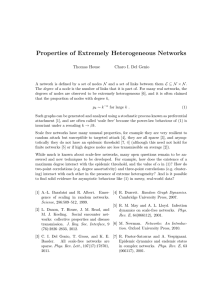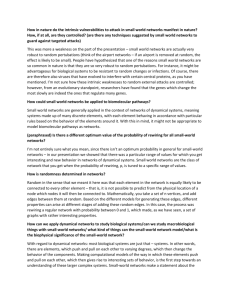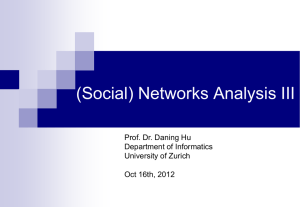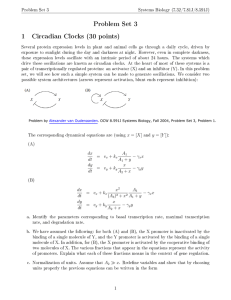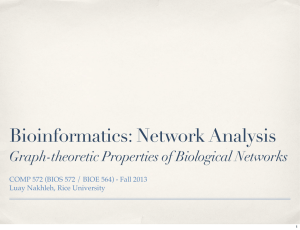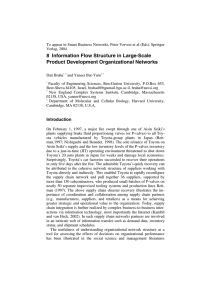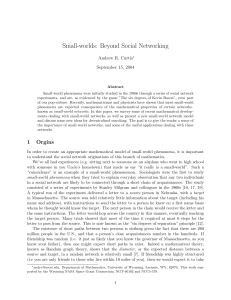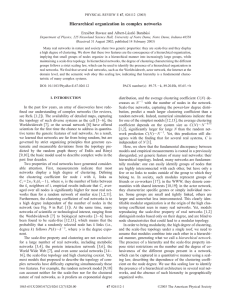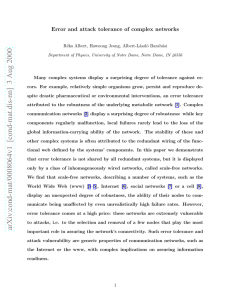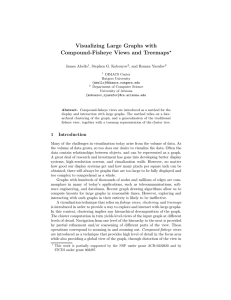The “New” Science of Network Duncan J. Watts Presents by Ronnie Feng
advertisement
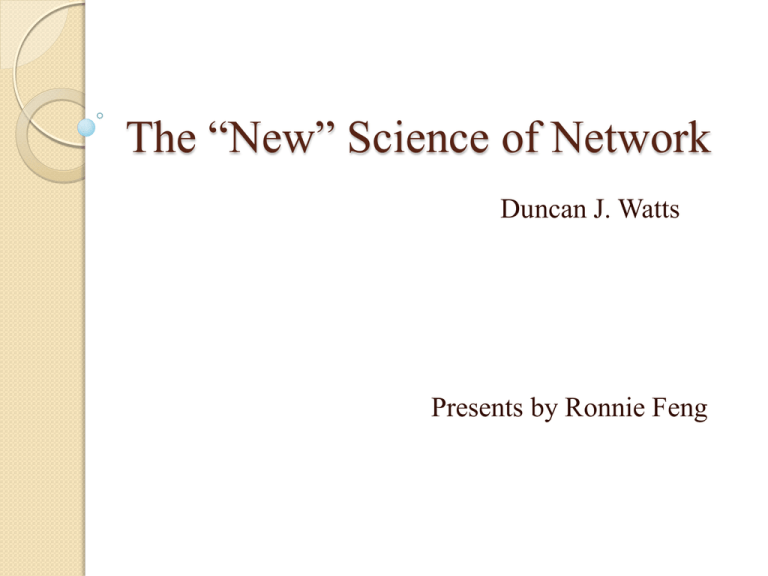
The “New” Science of Network Duncan J. Watts Presents by Ronnie Feng Introduction: Why • • • • it is the “NEW” science of network? New researches, reformation, innovation A label that gives the familiarity(to social network analysts) of many of its central ideas. The label does capture the sense of excitement and fast developing field. It generates across the many disciplines in which network related problems arise. Continue on introduction: Structure of the paper: Describes the main network modeling approaches and regards local structure, global connectivity, able to be searched and highly skewed degree distributions. Summarizes related empirical studies Applications of network modes Small-World Networks A type of mathematical graph in which most nodes are not neighbors of one another but somehow most nodes can be reached from every other by a small number of steps. The model interpolates between order and randomness. • Order: a uniform one-dimensional network which refers to each node was connected to its k nearest neighbors. • Randomness: parameter p (probability of link formation) that specified the fraction of randomly rewired links. Continues: Supported simple statistics: • Clustering coefficient C : local density • Average shortest path length L : measure of separation L and C can be measured as a function of p Continues: When p=0 (completely ordered), the network is “large” and “highly clustered” When p=1 (completely random), the network is “small” and “poor clustered” Many real-world networks: whether social networks or otherwise is ought to be small-world networks. Criticisms of the Model: The links are rewired uniformly at random, displayed short global path lengths, they could not exhibit searchability. The social networks are not built on a lattice substrate, whether one can account for clustering, short path lengths, and searchability in a less artificial manner will be a problem. The alternative model : Affiliation Network Comprise two nodes: N actors each of whom belongs to one or more of M groups. The “single mode” networks can be generated by projecting the bipartite network onto • Either the set of actors (“actor affiliation network” • Or the set of groups (“group interlock network”) A connection in the single mode network occurs whenever two actors/groups share at least one group/actor respectively. Example: Why it’s an alternative method When groups are classified according to more than one social dimension And when interactions have similarities within any given dimension. It not only are the resulting networks highly clustered with short global path lengths, but they are also searchable because of the ties between individuals. Scale-Free Networks: The distribution of the number of network neighbors – the degree distribution. Recall the definition of Scale-free: The relative probabilities of degree is a fixed ratio of the scales of those degrees. Continues: The regular network is one in which all nodes have the same degree. (normal distribution) The scale free is typically right –skewed with a “heavy tail”, meaning that a majority of nodes have less-than-average degree. More precious graph Empirical Network Analysis • • • • Small-world and scale-free networks application in a variety of realworld networks, such as genetic regulatory networks, biological neural network, food webs and transportation network etc. Network Motifs: the exploration of network structure beyond small-world and scalefree categorizations with their approach of detecting. Distinct subgraphs whose frequencies in a network can be used to characterize its local structure. Community Structure: an intermediate scale of analysis between local and global structure. Standard approaches to identifying community structure have tended to rely on some version of hierarchical clustering. The hierarchical clustering also bases on the similarity measures, however, has a tendency to split off poorly connected nodes, representing them as isolates rather than as members of the groups with which they would naturally be associated . Network and collective dynamics: Network affects sociologists because network are thought to influence individual and collective behavior, as well as the relationship between the two. Example 1 : Disease Spreading Model of Disease Spreading: Susceptible, Infected and Removed Model The populations S(t), I(t) and R(t) contain all current information about the state of the system. Continues: Example • • • 2 : Social Contagion It applies to a class of model that deal with collective decision making. The decisions are “transmitted” from one individual to another in a manner reminiscent of disease. Unlike the SIR model, social contagion tends to be a memory-free process, individual making decisions are affected simultaneously by past as well as current interaction. Conclusion: The idea and metrics of the “new” science of networks have either been borrowed from, or else rediscovered. The application of such network models show in diversified areas, especially the sociologists have much to gain from this progress and also much to contribute.
